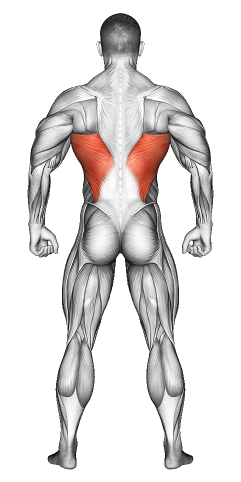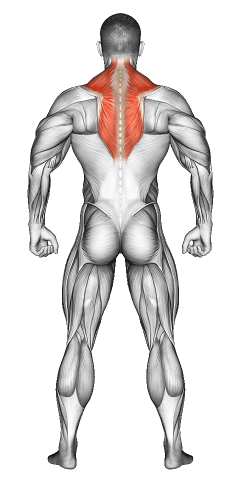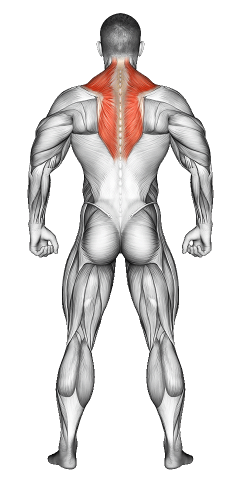Cable External Rotation: Video Tutorial & Exercise Guide

Written By: Claude Michael
Updated: Oct 13, 2024
| Workout | Cable External Rotation |
| Primary Muscle Group | Shoulders |
| Secondary Muscle Group | Lats, Traps |
| Equipment Required | Cable |
| Force Type | Pull |
| Mechanics | Isolation |
| Exercise Type | Strength |
| Difficulty | Beginner |
Cable External Rotation: Video Tutorial & Exercise Guide
- 1.Cable External Rotation: Muscle Groups
- -1.1Primary Muscle Group
- -1.2Secondary Muscle Group
- 2.Cable External Rotation: Step-by-Step Guide
- 3.Cable External Rotation: Overview
- 4.Cable External Rotation: Benefits
- 5.Cable External Rotation: Pro Tips & Advanced Techniques
- 6.Cable External Rotation: Progression Plan
- 7.Cable External Rotation: Frequently Asked Questions (FAQs)
Secondary Muscles Group

Lats

Traps
Cable External Rotation: Step-by-Step Guide
- Step 1: Set the cable machine to a low or mid-level position, with the handle attachment at elbow height. Stand perpendicular to the machine and grab the handle with the hand furthest from the machine, keeping your elbow bent at 90 degrees.
- Step 2: Position your elbow against your side to keep it stable. Your forearm should be across your body, pointing toward the cable machine.
- Step 3: Begin the movement by slowly rotating your forearm outward, keeping your elbow glued to your side. Rotate until your forearm is in line with your torso or as far as your shoulder mobility allows.
- Step 4: Slowly reverse the motion, bringing your forearm back across your body to the starting position. Keep the movement controlled and avoid jerking or using momentum.
- Step 5: Repeat for the desired number of reps, then switch to the opposite arm.
Cable External Rotation: Overview
The Cable External Rotation is a shoulder isolation exercise that primarily targets the rotator cuff muscles, particularly the infraspinatus and teres minor. These muscles are responsible for external rotation of the shoulder and play a key role in maintaining shoulder stability and mobility. This exercise is great for strengthening the shoulder's stabilizing muscles and preventing shoulder injuries.
The controlled, rotational movement makes the Cable External Rotation an essential exercise for those looking to improve shoulder health, increase range of motion, and strengthen the shoulder joint for better performance in pressing and overhead movements.
Cable External Rotations: Benefits
Cable External Rotations primarily target the rotator cuff muscles, helping to strengthen and stabilize the shoulder joint. This exercise improves shoulder mobility and reduces the risk of injury, especially for athletes or individuals who engage in overhead lifting.
Regularly performing this exercise enhances the overall function of the shoulder muscles, contributing to better posture, improved range of motion, and enhanced performance in pressing, pulling, and throwing movements.
The constant tension provided by the cable machine allows for smooth, controlled movements, ensuring consistent muscle engagement and reducing the risk of strain or injury.
Cable External Rotations: Pro Tips & Advanced Techniques
Keep your elbow tucked into your side to isolate the rotator cuff muscles and prevent compensating with your deltoids. Focus on a slow, controlled movement throughout the exercise, avoiding any jerky or rapid motions. To increase intensity, try holding the rotation for a second or two at the top of the movement. Ready to strengthen your shoulders? Let’s rotate!
Cable External Rotations: Progression Plan
Beginner
Intermediate
Advanced
Cable External Rotation: Frequently Asked Questions (FAQs)
What muscles do Cable External Rotations target?
+This exercise primarily targets the rotator cuff muscles, particularly the infraspinatus and teres minor, which help with shoulder external rotation and stabilization.
Are Cable External Rotations suitable for beginners?
+Yes, this exercise is great for beginners, especially those looking to strengthen their shoulder stabilizers and improve shoulder health. Start with light weights to learn proper form before increasing the resistance.
How can I make Cable External Rotations more challenging?
+To increase difficulty, gradually add more weight or slow down the rotation to increase time under tension. You can also add a brief pause at the top of the movement to further engage the rotator cuff muscles.
How often should I include Cable External Rotations in my routine?
+Include this exercise 2-3 times per week as part of your shoulder or upper body workout. It pairs well with other rotator cuff exercises like internal rotations or shoulder raises for a complete shoulder stability routine.
What common mistakes should I avoid?
+Avoid letting your elbow drift away from your side, as this reduces the effectiveness of the movement. Also, avoid using too much weight, which can lead to jerky movements and strain on the shoulder joint.
Don’t Wish for It, Work for It – Join the FlexXP Newsletter Today!
Thank you for signing up for the FlexXP Newsletter!
This site is protected and the Google Privacy Policy and Terms of Service apply.
